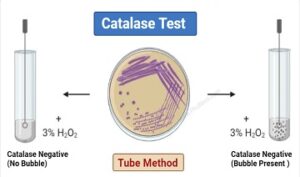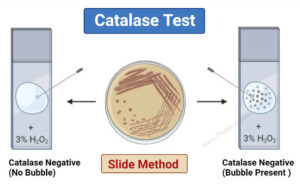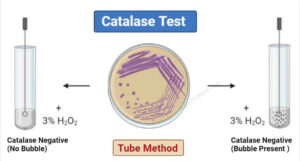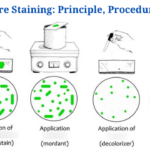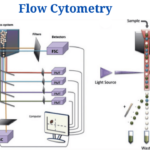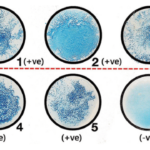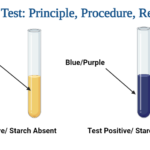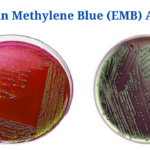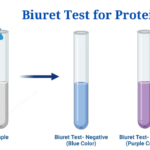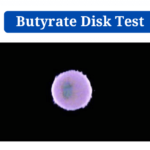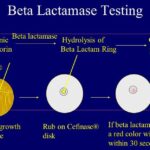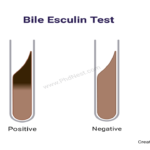What is Catalase Test?
Catalase is an enzyme, which is produced by microorganisms that live in oxygenated environments to neutralize toxic forms of oxygen metabolites; H2O2. The catalase enzyme neutralizes the bactericidal effects of hydrogen peroxide and protects them. Anaerobes generally lack the catalase enzyme.
This test demonstrate the presence of catalase, an enzyme that catalyses the release of oxygen from hydrogen peroxide (H2O2). It is used to differentiate those bacteria that produces an enzyme catalase, such as staphylococci, from non-catalase producing bacteria such as streptococci. Normally 3% H2O2 is used for the routine culture while 15% H2O2 is used for detection of catalase in anaerobes.
Objectives of Catalase Test
- To detect the ability of organisms to produce the catalase enzyme.
- To differentiate catalase-positive organisms like micrococci and staphylococci from catalase-negative organisms like streptococci.
Principle of Catalase Test
The metabolic activity of aerobic and facultative anaerobic microorganisms produce toxic by-products like hydrogen peroxide and superoxide radical (O2—).
These products are toxic to the organisms and might even result in cell lysis if not broken down. In the case of pathogenic organisms, different mechanisms are found that break down these products to non-toxic substances.
Bacteria capable of synthesizing the enzyme catalase hydrolyze hydrogen peroxide into water and gaseous oxygen, which results in the liberation of gas bubbles.
2H2O2 → 2H2O+ O2 (gas bubbles)
The production of catalase thus protects the organism against the lethal effect of hydrogen peroxide accumulated at the end of the aerobic metabolism.
The presence of the catalase enzyme can be demonstrated by adding hydrogen peroxide to the bacterial inoculum, which results in the rapid liberation of oxygen bubbles. The lack of enzyme is demonstrated by the absence of such bubbles.
Percentage of H2O2 used in catalase test
| Percentage | Purpose |
| 3% H2O2 | Routine testing of aerobes |
| 15% H2O2 | Identification of anaerobic bacteria. |
| 30% H2O2 | In the superoxol catalase (used for the presumptive speciation of certain Neisseria sps) |
Click Here for All Lab Notes
Purpose or Uses of Catalase Test
- The morphologically similar Enterococcusor Streptococcus (catalase negative) and Staphylococcus (catalase positive) can be differentiated using the catalase test.
- Also valuable in differentiating aerobic and obligate anaerobic bacteria.
- Semiquantitative catalase test is used for the identification of Mycobacterium tuberculosis.
- It is used to differentiate aerotolerant strains of Clostridium, which are catalase negative, from Bacillus species, which are positive.
- Catalase test can be used as an aid to the identification of Enterobacteriaceae.
Procedure of Catalase test
There are more than one method or procedure variations for the catalase test. These methods include the slide or drop catalase test, the tube method, the heat-stable catalase used for the differentiation of Mycobacterium species, the semiquantitative catalase for the identification of Mycobacterium tuberculosis, and the capillary tube and coverslip method. The most popular method of catalase test in clinical bacteriology is the slide or drop catalase method as it requires a small number of organisms and works on a relatively uncomplicated technique.
Slide Method
- Transfer a small amount of bacterial colony to a surface of a clean, dry glass slide using a loop or sterile wooden stick (be sure colony is visible to the naked eye on slide).
- Place a drop of 3% H2O2 on to the slide and mix.
- A positive result is the rapid evolution of oxygen (within 5-10 sec.) as evidenced by bubbling.
- A negative result is no bubbles or only a few scattered bubbles.*
- Dispose of your slide in the biohazard glass disposal container.
Tube Method
- Pour 1-2 ml of hydrogen peroxide solution into a test tube.
- Using a sterile wooden stick or a glass rod, take several colonies of the 18 to 24 hours test organism and immerse in the hydrogen peroxide solution.
- Observe for immediate bubbling.
Quality Control of Catalase Test
Positive: Staphylococcus aureus– ATCC 33592
Negative: Enterococcus faecalis– ATCC 29212
Precautions /Limitations of Catalase Test
- The test organisms should not be taken from blood agar culture. Red Blood cells contain catalase and their presence will give a false positive test.
- Culture should be 18 to 24 hours old.
- Hydrogen peroxide must be fresh as it is very unstable.
- Iron wire loop should not be used.
- Some bacteria produce a peroxidase that catalyzes a breakdown of hydrogen peroxide causing the reaction to be weakly positive; (a few bubbles elaborated slowly). This should not be confused with a truly positive reaction.
- Do not add organism to reagent, particularly if iron-containing inoculating loops are used. Iron containing loops will cause false positive test results if exposed to hydrogen peroxide.
Result and Interpretation of Catalase Test
- The positive test is demonstrated by the immediate appearance of bubbles.
- The appearance of one or two bubbles represents a weak reaction.
- A negative test is represented by no bubbles or a few bubbles after 20 s.
Reporting result
- The catalase test separates staphylococci (positive) from streptococci and enterococci (negative).
- Bacillus is catalase-positive, and Clostridium spp. are catalase-negative.
- The test is useful to separate among the fastidious Gram-negative rods.
- Neisseria gonorrhoeae produces an enhanced elaboration of bubbles not seen with other members of the genus due to superoxol.
Uses of Catalase Test
- The catalase test is primarily used to distinguish among Gram-positive cocci: members of the genus Staphylococcus are catalase-positive, and members of the genera Streptococcus and Enterococcus are catalase-negative.
- Catalase test is used to differentiate aerotolerant strains of Clostridium (catalase-negative) from Bacillus species (catalase-positive).
- A semiquantitative catalase test is used for the identification of Mycobacterium tuberculosis.
- Catalase test is useful to separate among the fastidious Gram-negative rods.
- Catalase test can be used as an aid to the identification of Enterobacteriaceae. Members of the Enterobacteriaceae family are catalase positive.
- Neisseria gonorrhoeae produces an enhanced elaboration of bubbles not seen with other members of the genus due to superoxol.
References and sources
- Karen Reiner. Catalase Test Protocol. Created: Thursday, 11 November 2010. American Society for Microbiology. 2016.
- 8% – https://asm.org/getattachment/72a871fc-ba92-4128-a194-6f1bab5c3ab7/Catalase-Test-Protocol.pdf
- 2% – https://www.ijsr.net/archive/v6i12/ART20178878.pdf
- 2% – https://www.dalynn.com/dyn/ck_assets/files/tech/RC35.pdf
- 2% – https://clinicalsci.info/catalase-test/
Related Posts
- Anisocytosis: Definition, Types, Causes, Symptoms, Treatment
- Endospore Staining: Principle, Procedure, Reagents, Results
- Flow Cytometry: Overview, Principle, Steps, Types, Uses
- Northern Blot: Overview, Principle, Procedure and Results
- MPV Blood Test: Calculation, High and Low MPV Value, Results
- Latex Agglutination Test: Objectives, Principle, Procedure, Results
- Iodine Test: Definition, Objective, Principle, Procedure, Results
- Eosin Methylene Blue (EMB) Agar
- Biuret Test for Protein: Purpose, Objectives, Principle, Procedure, Reagents
- Streak Plate Method: Meaning, Principle, Methods, Importance, Limitations
- Bile Solubility Test: Objective, Principle, Procedure, Results, Uses
- Butyrate Disk Test: Objective, Principle, Procedure, Results, Uses, Limitations
- Beta Lactamase Test: Objective, Principle, Procedure, Results, Limitations
- Bacitracin Susceptibility Test: Objective, Principle, Procedure, Results, Uses, Limitations
- Bile Esculin Test: Objective, Principle, Procedure, Result, Uses, Limitations

